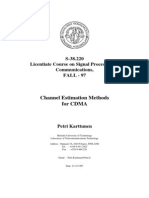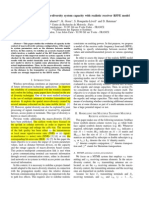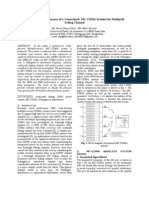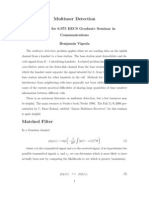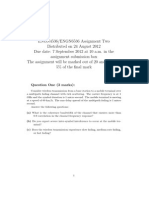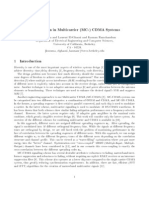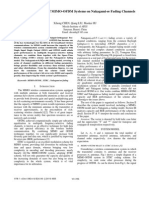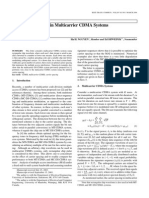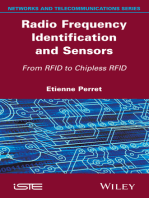MIMO-Rake Receiver in WCDMA
MIMO-Rake Receiver in WCDMA
Uploaded by
Lê Minh NguyễnCopyright:
Available Formats
MIMO-Rake Receiver in WCDMA
MIMO-Rake Receiver in WCDMA
Uploaded by
Lê Minh NguyễnCopyright
Available Formats
Share this document
Did you find this document useful?
Is this content inappropriate?
Copyright:
Available Formats
MIMO-Rake Receiver in WCDMA
MIMO-Rake Receiver in WCDMA
Uploaded by
Lê Minh NguyễnCopyright:
Available Formats
Analytical Results for BER Performance of
MIMO-Rake Receiver in WCDMA System
Mr. Pravindra Kumar, * Mr. Anand Kumar,
Department of Electronics and Communication Engineering, Roorkee Engineering & Management
Technology Institute, Shamli (INDIA)
*Department of Applied Science, Krishna Institute of Management & Technology, Moradabad (INDIA)
E-mail: ait.pravs@gmail.com, * anand12617_ibs@rediffmail.com
Abstract The use of Rake Receiver in Wideband Code Division Multiple Access (WCDMA) system
provides a unique and valuable means of combating the adverse effects of short-term multipath fading in
mobile radio propagation environments. The transmitted signal bandwidth in WCDMA system is much
larger than the coherent bandwidth of the channel, in this case the channel is frequency selective channel.
BER performance of Rake Receiver can improve by using Spatial Multiplexing (SM) in WCDMA
systems. In general, the SM increases the data rate and the diversity order as well. The approximate
maximum likelihood detector is derived in this paper and it shown that the diversity order is related to
the product of the numbers of receives antennas and taps (the number of Resolvable Paths or the number
of Rake Fingers). Spatial Multiplexing can be realized using multiple antennas at the base station and the
mobile terminal i.e. Multiple Input Multiple Output (MIMO) system. In this paper BER performance of
MIMO-Rake receiver is analysed and also compared with the generalized Rake Receiver system.
I ndex Terms MIMO System, WCDMA, Rake Receiver, Spatial Multiplexing.
I. INTRODUCTION:-
WCDMA [1] is a broadband technology with high potential for third generation (3G) mobile systems. Due to
reflection from obstacles a radio channel can consists of many copies of originally signal having different
amplitude, phase and delay. If the signal components arrive more than duration of one chip apart from each
other, a Rake Receiver [2], [3] can be used to resolve and combine them.
Generalized Rake Receiver These are simple Rake Receivers used in WCDMA systems to collect energy
from multipath channels. A Rake Receiver can be seen as filter matched to the spreading code, pulse shaping
filter and multipath channel. It is a combination of specified number of elementary receivers called Rake
fingers. Each finger is associated with one of the multipath signals. The outputs of the Rake fingers are
combined to detect the transmitted symbols. Fig.1 shows the Generalized Rake Receiver.
Fig.1. Generalized Rake Receiver with M fingers
The BER performance of generalized Rake Receiver is shown in references- [4], [5], [6]. From these references
we know that if we increase the number of fingers, BER performance of Rake Receiver is improved .The
number of available fingers depends on the channel profile and chip rate, the more the resolvable paths (taps)
there, and higher chip rate will cause wider bandwidth. To catch all the energy from the channel more Rake
fingers are needed. A very large number of fingers lead to combining losses, practical implementation problems
and design complexity. The diversity order is directly related to the number of Rake Fingers. Thus the diversity
order is limited because of the limitation of the use of number of Rake Fingers
Pravindra Kumar et al. / International Journal of Engineering Science and Technology (IJEST)
ISSN : 0975-5462 Vol. 3 No. 10 October 2011 7530
MIMO-Rake Receiver MIMO Rake Receiver can increase the diversity order. It can also overcome the
design complexity, combining losses using large number of Rake fingers in generalized Rake Receiver. In this
paper we are using 2 2 MIMO system and we are using generalized Rake Receiver at both Receiving
antennas. The Block Diagram of MIMO-Rake Receiver is in fig.2.
Fig.2. MIMO-Rake Receiver
The objective of this paper is to get higher order diversity, and to improve the BER performance of Rake
Receiver. This paper is organised as follows - At first the performance is investigated with the generalized Rake
receiver system, then that is investigated with MIMO-Rake Receiver systems.
II. REVERSE LINK SYSTEM MODLE :-
Block diagrams of reverse link system model is in Fig.3.The number of users are from 0 to K-1. Here the
modulation technique is BPSK.
Fig.3. Reverse link system model
Let us assume that there are K independent users transmitting signals in the DS-CDMA system. Each of them
transmits the signal in the form as [7]:
( ) 2 ( ) ( ) ( )
k k k k k k k c k
S t P b t a t Cos t = +
.. (1)
Where - ( )
k
b t - binary data sequence;
( )
k
a t
- pseudo random sequence;
k
P - power of the transmitted signal;
c
- the carrier angular frequency;
k
- time delay that accounts for the lack of synchronism between the
transmitters, and
k
- phase angle of the k
th
carrier. The k
th
users data signal is a sequence of unit amplitude
rectangular pulse of duration Tb, taking values {-1, +1} with the equal probability. This sequence can be
expressed as
( ) ( )
k
k j b b
j
b t b P T t j T
=
=
. (2)
Where
1
b
PT =
, for 0 t <
b
T , and
0
b
PT =
, otherwise. The spreading signal
( )
k
t a
can be expressed as:
( ) ( )
k
k i c
i
t t i T a a
=
=
.. (3)
Where ( ) t is a chip wave form that is time limited to
[0, ]
c
T
and normalized to have energy
c
T
, where
Pravindra Kumar et al. / International Journal of Engineering Science and Technology (IJEST)
ISSN : 0975-5462 Vol. 3 No. 10 October 2011 7531
2
0
( )
c
T
c
t dt T =
}
is the chip period, and
( ) k
i
a is the
th
i chip value of k
th
user; This chip value can be either -1 or +1.
If
c
T
is the chip period and there are
c
N
chips per bit, thus
c b c
N T T = is the spreading factor of user K. Let the
desire user is K=0 and all other users contribute to MAI.
If ( )
k
h t is the low pass impulse response of the Frequency Selective Fading channel then-
,
, ,
1
( ) ( )
k
k
k l
k
k k l k l
k
k
L
j
t
l
t h e
=
=
.. (4)
Where
, k l
k
and
, k l
k
are the phase and time delays introduced by the channel; they can be assumed to be random
variables uniformly distributed in [0, 2 ) and [0,
max
T
) respectively, where
max
T
is the maximum delay at which
there can be multipath ray.
k
L is the number of multipaths generated by frequency selective channel for the k
th
transmitted signal.
, k l
k
are the path gain components with Rayleigh distribution:
2
2
( ) e x p f
=
`
)
. . (5)
The received signal is:
( ) ( ) . ( ) ( )
k i
r t h t S t n t = +
.. (6)
Thus the total received signal can be written as:
( ) ( ) ( )
1
, , , ,
0
1
2 ( ) ( ) ( )
k
k k l k k l k k l c k l
k k k k
k
k
k
L
P b t C o s C o s t
l
r t t a t n t
=
=
= + +
(7)
Where ( ) n t is Additive White Gaussian Noise (AWGN) with a two sided power spectral density of No/2 .Where
No is the noise power spectral density measured in watts/hertz (joules). Now the decision statistic is:
0 0 0 , 0
0
( ) ( ) ( )
b
T
c
Z r t a t Cos t dt =
}
0
1
0
0 0 , 0 ,
0 [ 1, 1]
2
k
k
L K
b k l
k
k l l
P
b T
= =
= + +
. (8)
Where
0
b is the transmitted bit from user
0,0
0, is the amplitude of the desired multipath component,
0
P is the
transmitted power of the desired user, and
0 0 , 0
0
( ) ( ) ( )
b
T
c
n t a t C o s t d t =
}
. (9)
is a Zero-mean Gaussian random variable with variance
2 0
4
b
N T
=
, we can re-write the decision statistic in
(8) as -
0 0
Z D = + +
(10)
Where
0
D
- desired signal component (1
st
term in (8)), - the MAI (2
nd
term in (8)), and - the AWGN.
In case of cellular networks, it is worth to decompose the MAI term in to two distinct contributes:
0 I
= +
,
where
0
is the interfering signal due to users within the same cell of the desired user (own-cell interference)
and
I
is the interfering signal due to presence of active users in other cells surrounding the cell of interest
(inter-cell interference). Hence:
0 0 0 I
Z D = + + +
. (11)
It is conceivable to suppose that 0 and I is statistically independent.
II. GENERALIZED RAKE RECEIVER :-
The block diagram of Generalized Rake Receiver is in fig.4. Here
*
( )
k
h t
is the estimated channel value. The
channel estimated value is multiply with the each received signal and do the integration from 0 to
b
T
after this
calculate the summation of all the estimated signal. The real part of this is known as the decision variable and
then pass it through the decision device to get the decision about the bit whether it is 0 or 1. With the concept of
Rake receiver in multipath fading channel the useful term in (10) becomes [8]:
0
0
0
0 0 ,
1
2
o
L
b l
l
P
D T
=
=
.. (12)
Here
0
l indicates the number of multipath rays relative to the useful signal, received with amplitude
0
0 0,l
P
Pravindra Kumar et al. / International Journal of Engineering Science and Technology (IJEST)
ISSN : 0975-5462 Vol. 3 No. 10 October 2011 7532
Fig.4. Block Diagram of Generalized Rake Receiver.
In case of frequency-selective fading, with the hypotheses of identical mean number L of multipaths for each
source and identical mean number of users per cell, it is possible obtaining:
0 0 0
2 2 2 2
2 2 2
, 0 ,
0 { } { }{ 1} { }{ 1}
3 3
k
b
k k l
c
b
c
A T A T
E E K E L K
N N
= +
2 2 2
2
0
( 1) 2
{ }
3
b
c
L K A T
E
N
=
.(13)
1 1 1
2 2
2 2 4
,
{ } { } { }
3
k
b
I k l k
c
A T
E E E L K
N
=
2 2
2
2
5 3
b
c
LK A T
N
=
.. (14)
Where
0
0
,
k
k l
are the path gains affecting signals of the reference cell,
1
1
,
k
k l
are the path gains affecting signals of
the surrounding cells, 1
1
0
1,
0 ,
k
k
k
r
r
=
is the ratio between the distance of the 1 k -th user of a surrounding cell from
its home base station
1
1,
( )
k
r and from the reference base station
0
0,
( )
k
r
. If the path gains are identically Rayleigh
distributed and
1
k
is uniform in (0, 1], we obtain:
0 0 1 0 1
2 2 2 2
, 0 , ,
{ } { } { } 2
k k
k k l k l
E E E = = =
; and
1
4
1
{ }
5
k
E =
.. (15)
If we consider that the fading is sufficiently slow to allow us to estimate the channel
( )
k
h t
perfect (with out
noise). Furthermore, within any signaling interval,
( )
k
h t
is treated as a constant and denoted as
k
h . Thus the
decision variables are represented as
* *
1
0
R e ( ) ( / ) ; 1, 2
b
T
M
m k l l m
k
U h r t S t k w d t m
=
(
= =
(
(
}
(16)
Where
m
U
represent the decision variables;
*
( )
lm
S t
is the transmitted signal transmitted signal and
( )
l
r t
is the
received signal. If the transmitted signal is
1
( )
l
S t
, then the received signal is:
1
1
( ) ( / ) ( )
M
l n l
n
r t h S t n w n t
=
= +
(17)
Thus -
* *
1
1 1
0
Re ( / ) ( / )
b
T
M M
m k n l lm
k n
U h h S t n w S t k w dt
= =
(
=
(
(
}
* *
1
0
Re ( ) ( / )
b
T
M
k lm
k
h n t S t k w dt
=
(
+
(
(
}
; 1, 2 m=
..... (18)
If we assume that our binary signals are designed to satisfy this property then,
2
*
1
1
0
Re ( / ) ( / )
b
T
M
m k l lm
k
U h S t k w S t k w dt
=
(
=
(
(
}
* *
1
0
Re ( ) ( / )
b
T
M
k lm
k
h n t S t k w dt
=
(
+
(
(
}
; 1, 2 m= ..... (19)
When the binary signals are antipodal, a single decision variable suffices. In this case reduces to:
2
1
1 1
R e 2
M M
b k k k
k k
U E N
= =
(
= +
(
; Where
k k
h =
and *
0
( ) ( / )
b
T
j k
k i
N e n t S t k w dt
=
}
...(20)
Pravindra Kumar et al. / International Journal of Engineering Science and Technology (IJEST)
ISSN : 0975-5462 Vol. 3 No. 10 October 2011 7533
BIT-ERROR PROBABILITY FOR GENERALIZED RAKE RECEIVER- For coherent BPSK with
Rayleigh Frequency Selective Fading channel with using convolution coding at the transmitter side the coded
bit-error probability of Rake with MRC assuming identical noise in each branch is [4]:
1 1
0
1 1
2 2
M j
M M j
c
j
j
BEP
+
=
+ | | | | | |
=
| | |
\ . \ . \ .
.. (21)
Where-
0
2
1
2
1 1 1
2. . 3. . 5
c
b a c
N M
LK
r E D N
=
( | |
+ + +
| (
\ .
Where M is the number of fingers in Rake Receiver,
c
M
is the interfering cells equipped by conventional
correlation type receiver at the base station with perfect implementing the power control. L is the number of
multipaths per signal.
b
E is the energy per bit and
0
2 N
is the two-sided power spectral density of the thermal
noise,
a
D
is the directivity of Base station antenna, r is the code rate of error control coding (convolutional
coding),
c
N
is the spreading factor, Kis the number of users using the channel simultaneously.
Now if we are using viterbi decoding [9] at the receiver side. The BER performance of Generalized Rake
Receiver is-
( )
( ) 1; 1; 2 1
; ;
c c
N
J N D BEP BEP
d
BER T D J N
d
= = =
. (22)
Where
( ) ; ; T D J N
denotes the transfer function of the signal flow graph. The exponent of D on a branch
describes the hamming weight of encoder output corresponding to that branch. The exponent of J is always
equal to 1, since the length of each branch is one. The exponent of Ndenotes the number of 1s in the
information sequence for that path. (i.e. for input 0, exponent of N is 0 and for input 1, it is equal to1).
III. MIMO-RAKE RECEIVER-
This section has two sub sections-
A. MIMO with ML Equalization-
In this paper, we will discuss another receiver structure called Maximum Likelihood (ML) decoding [10], [11]
which gives us an even better performance. Now we assume that the channel is a flat fading Rayleigh multipath
channel and the modulation is BPSK.
Fig.5. MIMO Structure
In a 22 MIMO channel with two transmit antennas if we have a transmission sequence, for example
1 2 3
, , ,.......,
n
X X X X
, In normal transmission, we can send
1
X
in the first time slot,
2
X
in the second time slot,
3
X
and so on. Now as we now have 2 transmit antennas, we may group the symbols into groups of two. In the
first time slot, send
1
X
and
2
X
from the first and second antenna. In second time slot, send
3
X
and
4
X
from the
first and second antenna, send
5
X
and
6
X
in the third time slot and so on. From here we notice that by grouping
two symbols and sending them in one time slot, we need only 2 n time slots to complete the transmission i.e.
data rate is doubled. This forms the simple explanation of a MIMO transmission scheme with two transmit
antennas and two receive antennas.
Let us now try to understand the math for extracting the two symbols which interfered with each other. In
the first time slot, the received signal on the first receive antenna is,
1
1 1,1 1 1, 2 2 1 1,1 1, 2 1
2
X
Y h X h X n h h n
X
(
( = + + = +
(
.. (23)
Pravindra Kumar et al. / International Journal of Engineering Science and Technology (IJEST)
ISSN : 0975-5462 Vol. 3 No. 10 October 2011 7534
The received signal on the second receive antenna is,
1
2 2 ,1 1 2 , 2 2 2 2 ,1 2 , 2 2
2
X
Y h X h X n h h n
X
(
( = + + = +
(
.. (24)
Where-
1
Y
,
2
Y
are the received symbol on the first and second antenna respectively,
1,1
h
is the channel from first
transmit antenna to first receive antenna,
1, 2
h
is the channel from second transmit antenna to first receive
antenna,
2,1
h
is the channel from first transmit antenna to second receive antenna,
2,2
h
is the channel from
second transmit antenna to second receive antenna,
1
X
and
2
X
are the transmitted symbols and
1
n
,
2
n
is the
noise on first and second receive antennas. We assume that the receiver knows
1,1
h
,
1, 2
h
,
2,1
h
and
2,2
h
. The
receiver also knows
1
Y
and
2
Y
. The unknowns are
1
X
and
2
X
.
For convenience, the above equation can be represented in matrix notation as follows:
1,1 1, 2
1 1 1
2 2,1 2, 2 2 2
h h
Y X n
Y h h X n
(
( ( (
= +
(
( ( (
. (25)
Equivalently, Y HX n = + (26)
We have assume here that - The channel experience by each transmit antenna is independent from the channel
experienced by other transmit antennas. The channel experienced between each transmit to the receive antenna
is independent and randomly varying in time. The channel is known at the receiver.
Maximum Likelihood (ML) Receiver - The Maximum Likelihood receiver tries to find
X (estimate of the
transmitted symbol X) which minimizes,
2
J Y HX =
. If we are using BPSK modulation, the possible values
of
1
X is +1 or -1 similarly
2
X also take values +1 or -1. So, to find the Maximum Likelihood solution, we
need to find the minimum from the all four combinations of
1
X
and
2
X .
2
J Y HX =
. (27)
So-
2
1,1 1, 2
1 1
2 1,2 2,2
2
h h
Y X
J
Y h h
X
(
(
(
= (
(
(
(
. (28)
The four combination of
1
X
and
2
X
are : +1,+1; +1,-1; -1,+1; -1,-1. Therefore-
2 2
1,1 1,2 1,1 1,2
1 1
1, 1 1, 1
2 1,2 2,2 2 1,2 2,2
2
1,1 1,2 1,1 1,2
1 1
1, 1 1, 1
2 1,2 2,2 2 1,2 2,2
1 1
;
1 1
1
;
1
h h h h
Y Y
J J
Y h h Y h h
h h h h
Y Y
J J
Y h h Y h h
+ + +
+
( ( + + ( ( ( (
= =
( (
( ( ( (
+
( ( ( (
= =
(
( ( (
+
2
1
1
`
( (
(
(
)
.. (29)
The estimate of the transmit symbol is chosen based on the minimum value from the above four values i.e. if the
minimum is
[ ]
1, 1
1 1 J
+ +
, if the minimum is
[ ]
1, 1
1 0 J
+
, if the minimum is
[ ]
1, 1
0 1 J
+
and if the
minimum is
[ ]
1, 1
0 0 J
.
The results for 22 MIMO with Maximum Likelihood (ML) equalization [11] helped us to achieve a
performance closely matching the 1 transmit 2 receive antenna Maximal Ratio Combining (MRC) case.
B. BIT-ERROR PROBABILITY FOR GENERALIZED MIMO RAKE RECEIVER-
For coherent BPSK with Rayleigh Frequency Selective Fading channel with using convolution coding at the
transmitter side the coded bit-error probability of MIMO-RAKE Receiver with ML equalizer, assuming
identical noise in each branch, is given as-
1 1
0
1 1
2 2
d j
d d j
c
j
j
BEP
+
=
+ | | | | | |
=
| | |
\ . \ . \ .
.. (30)
Pravindra Kumar et al. / International Journal of Engineering Science and Technology (IJEST)
ISSN : 0975-5462 Vol. 3 No. 10 October 2011 7535
Where-
0
2
1
2
1 1 1
2. . 3. . 5
c
b a c
N M
L K
r E D N
=
( | |
+ + +
| (
\ .
. d M A = ; M is the number of Rake fingers attached with one antenna in MIMO arrangement; Ais the
number of Antenna used in MIMO arrangement.
IV. PERFORMANCE ANALYSIS-
In Fig.6 the number of multipaths L =8; the number of Users K=3; Spreading Factor
c
N
=32; Antenna
Directivity
a
D
= 5dB; Number of Interfering Cells
c
M
=4; n umber of Rake Fingers M =3; Code Rate r =1/2;
Constraint length
L
C
=3. From this at BER value of
4
10
there is 8 dB improvements in BER Performance of
communication system with using MIMO Rake Receiver in comparison with Generalized Rake Receiver with 3
taps (i.e. with 3 resolvable paths).
In fig.7 the number of multipaths L =8; the number of Users K=1 to 40; Spreading Factor
c
N
=32; Antenna
Directivity
a
D
= 5dB; Number of Interfering Cells
c
M
=4;
b o
E N
=9 dB; number of Rake Fingers M =3; Code
Rate r =1/2; Constraint length
L
C
=3. From this at BER value of
4
10
there is 1 user with 22 MIMO system
with 1 tap, 3 users with generalized Rake Receiver with 3 taps, 12 users with 22 MIMO Rake Receiver with 3
taps; Therefore there is capacity improvement in using MIMO Rake Receiver in comparison with Generalized
Rake Receiver.
Fig. 6 Fig.7
REFERENCES
[1] J.Cheng, and N.C.Beaulieu Accurate DS-CDMA bit-error probability calculation in Rayleigh fading, IEEE on wireless
Communications, vol. 1, no.1, pp. 3-15, Jan.2002
[2] Hatem Boujemaa, BER Performance Analysis of the Discrete Time and Continuous Time Rake Receivers for the UMTS Downlink,
IEEE Transactions on Wireless Communications. Vol. 5, NO. 4, April 2006.
[3] Chen Wei WuLinyan MengNan, BER Analysis of Rake Receiver in Rayleigh Fading Channel, wuhan Uniuversity of Technology,
China
[4] Pravindra kumar, B.K.Kanaujia, M.Gangadharappa Analytical Results for BER Performance of Rake Receiver In Rayleigh Fading
Channel for UMTS environment, 6th IEEE conference on Wireless Communication and Sensor Networks, WCSN-2010 in IIIT-
Allahabad (INDIA), ISBN: 978-1-4244-9731-7, Dec-2010.
Pravindra Kumar et al. / International Journal of Engineering Science and Technology (IJEST)
ISSN : 0975-5462 Vol. 3 No. 10 October 2011 7536
[5] Pravindra kumar, B.K.Kanaujia, M.Gangadharappa BER Performance Analysis of Rake Receiver in Rayleigh Fading Channel for
UMTS environment, International Journal of Engineering Science and Technology (IJEST), ISSN: 0975-5462, Vol. 2(6), pp.- 1690-
1698. June-2010.
[6] LEE LI YING Ber Performance Simulation of Rake Receiver foe WCDMA System, e-thesis, 11 May 2007.
[7] T.S.Rappaport, Wireless Communications Principles and Practice, Prentice Hall, New Jersey, 1996.
[8] Jeich Mar, Hung-Yi Chen, Performance Analysis of Cellular CDMA Networks over Frequency Selective Fading Channel, IEEE
Transactions on Vehicular Technology, Vol. 47, No. 4, Nov. 1998.
[9] A.J. Han Vinck, The Viterbi Algorithm Lecture notes data Communications, 10.01.2009, Institute for Experimental Mathematics
Ellernstrasse 29, 45326 Essen-Germany.
[10] Volker Jungnickel, Yun-Shen Chang and Volker Pohl, Performance of MIMO Rake Receivers in WCDMA Systems, Fraunhofer
Institute for Telecommunications, Heinrich-Hertz-Institute, Einsteinufer 37, D-10587 Berlin, Germany. WCNC 2004, IEEE
Communications Society,
[11] Krishna Sankar MIMO With ML Equalization, e-notes on www.dsplog.com, posted on December 14, 2008.
AUTHORS BIOGRAPHIES:
Mr. Pravindra Kumar He has done M.Tech. in Digital Communication (D.C) from Ambedkar
Institute of Technology, Delhi (I.P. Univ., Delhi). He received his B.Tech Degree in Electronics
and Communication Engineering from Ideal Institute of Technology, Ghaziabad (U.P) and B.Sc.
degree from C. C. S. Univ., Meerut. He has 3
+
years of teaching experience. His teaching and
research interests are the wireless communication and digital signal processing. He has published
five papers in International Journal and one in IEEE. He is working as an Assistant Professor in
REMTech, Shamli (U.P).
Mr. Anand Kumar - He has done M. Phil from Dr. B.R.Ambedkar Univ.,Agra (U.P). He received
his M.Sc and B.Sc degree from M. J. P. Rohilkhand Univ., Bareilly (U.P). He has 3
+
years of
teaching experience. His research interest area is bicomplex number. He has published two paper
in international journal and also has good Gate Score-2011. He is working as Assistant Professor
in KIMT, Moradabad (U.P).
Pravindra Kumar et al. / International Journal of Engineering Science and Technology (IJEST)
ISSN : 0975-5462 Vol. 3 No. 10 October 2011 7537
You might also like
- Eigen Value Based (EBB) Beamforming Precoding Design For Downlink Capacity Improvement in Multiuser MIMO ChannelNo ratings yetEigen Value Based (EBB) Beamforming Precoding Design For Downlink Capacity Improvement in Multiuser MIMO Channel7 pages
- S-38.220 Licentiate Course On Signal Processing in Communications, FALL - 97No ratings yetS-38.220 Licentiate Course On Signal Processing in Communications, FALL - 9715 pages
- Adaptive Beamforming For Ds-Cdma Using Conjugate Gradient Algorithm in Multipath Fading ChannelNo ratings yetAdaptive Beamforming For Ds-Cdma Using Conjugate Gradient Algorithm in Multipath Fading Channel5 pages
- Performance Evaluation of Alamouti Space-Time Block Coded Multi-User W-CDMA Wireless Communication SystemNo ratings yetPerformance Evaluation of Alamouti Space-Time Block Coded Multi-User W-CDMA Wireless Communication System5 pages
- Macro-Diversity Versus Micro-Diversity System Capacity With Realistic Receiver RFFE ModelNo ratings yetMacro-Diversity Versus Micro-Diversity System Capacity With Realistic Receiver RFFE Model6 pages
- Neural Network Based Receiver For Multiuser Detection in MC-CDMA SystemsNo ratings yetNeural Network Based Receiver For Multiuser Detection in MC-CDMA Systems10 pages
- Reverse Link Performance of A Generalized MC CDMA-ICECCNo ratings yetReverse Link Performance of A Generalized MC CDMA-ICECC4 pages
- Performance Analysis of A Trellis Coded Beamforming Scheme For MIMO Fading ChannelsNo ratings yetPerformance Analysis of A Trellis Coded Beamforming Scheme For MIMO Fading Channels4 pages
- Iterative Multiuser Detection Vigoda SummaryNo ratings yetIterative Multiuser Detection Vigoda Summary18 pages
- Transmit Diversity Technique For Wireless Communications: By, Undety Srinu, EC094220 (ACS)No ratings yetTransmit Diversity Technique For Wireless Communications: By, Undety Srinu, EC094220 (ACS)21 pages
- Capacity Evaluation of Cellular CDMA: Q Ang WangNo ratings yetCapacity Evaluation of Cellular CDMA: Q Ang Wang8 pages
- Optimization in Multicarrier (MC-) CDMA SystemsNo ratings yetOptimization in Multicarrier (MC-) CDMA Systems10 pages
- UWB System Based On The Modified Gegenbauer Function in MISO ChannelNo ratings yetUWB System Based On The Modified Gegenbauer Function in MISO Channel7 pages
- Mimo Generalized Decorrelating Discrete-Time Rake Receiver: Tunc Er Baykas, Mohamed Siala, Abbas Yongac o GluNo ratings yetMimo Generalized Decorrelating Discrete-Time Rake Receiver: Tunc Er Baykas, Mohamed Siala, Abbas Yongac o Glu4 pages
- A Tutorial On SISO and MIMO Channel CapacitiesNo ratings yetA Tutorial On SISO and MIMO Channel Capacities4 pages
- L-3/T-,2/EEE Date: 09/06/2014: To Obtain A PAM Signal, Where, Is The Width of Pulse. What Is TheNo ratings yetL-3/T-,2/EEE Date: 09/06/2014: To Obtain A PAM Signal, Where, Is The Width of Pulse. What Is The34 pages
- Robustness of DS-CDMA Multiuser Detectors: Pål Orten and Tony OttossonNo ratings yetRobustness of DS-CDMA Multiuser Detectors: Pål Orten and Tony Ottosson5 pages
- Performance Improvement of Mc-Cdma System Through DSTBC Site DiversityNo ratings yetPerformance Improvement of Mc-Cdma System Through DSTBC Site Diversity8 pages
- IAETSD-A Novel Scheduling Algorithms For MIMO Based Wireless NetworksNo ratings yetIAETSD-A Novel Scheduling Algorithms For MIMO Based Wireless Networks10 pages
- Iterative Data Detection and Channel Estimation For Single-Parity Check-Product Coded MIMO Wireless Communications SystemNo ratings yetIterative Data Detection and Channel Estimation For Single-Parity Check-Product Coded MIMO Wireless Communications System5 pages
- Joint Scheduling and Random Beamforming with reduced feedback in multiuser MIMO-OFDMNo ratings yetJoint Scheduling and Random Beamforming with reduced feedback in multiuser MIMO-OFDM4 pages
- Riciain Channel Capacity Comparison Between (8X8) and (4x4) MIMONo ratings yetRiciain Channel Capacity Comparison Between (8X8) and (4x4) MIMO5 pages
- Performance Analysis of MIMO-OFDM Systems On Nakagami-M Fading ChannelsNo ratings yetPerformance Analysis of MIMO-OFDM Systems On Nakagami-M Fading Channels5 pages
- On Carrier Spacing in Multicarrier CDMA Systems: LetterNo ratings yetOn Carrier Spacing in Multicarrier CDMA Systems: Letter4 pages
- Performance Analysis of Power Line Communication Using DS-CDMA Technique With Adaptive Laguerre FiltersNo ratings yetPerformance Analysis of Power Line Communication Using DS-CDMA Technique With Adaptive Laguerre Filters5 pages
- Maximum Ratio Combining For A WCDMA Rake ReceiverNo ratings yetMaximum Ratio Combining For A WCDMA Rake Receiver8 pages
- Final: Total 200 Points, Duration: 12:15pm-3:15pm: EE 359 - Wireless Communications - Autumn 2016No ratings yetFinal: Total 200 Points, Duration: 12:15pm-3:15pm: EE 359 - Wireless Communications - Autumn 20163 pages
- MIMO Systems and Channel Models ProposalNo ratings yetMIMO Systems and Channel Models Proposal11 pages
- Of Cdma: Performance Multi-Code in A Multipath Fading ChannelNo ratings yetOf Cdma: Performance Multi-Code in A Multipath Fading Channel6 pages
- I. Berenguer Is Supported by A Fulbright FellowshipNo ratings yetI. Berenguer Is Supported by A Fulbright Fellowship25 pages
- IJRET - Iterative QR Decompostion Channel Estimation For Mimo-Ofdm SystemsNo ratings yetIJRET - Iterative QR Decompostion Channel Estimation For Mimo-Ofdm Systems7 pages
- Performance Analysis of Multiuser MIMO Systems With Zero Forcing ReceiversNo ratings yetPerformance Analysis of Multiuser MIMO Systems With Zero Forcing Receivers5 pages
- Successive Interference Cancellation Schemes in Multi-Rate Ds/Cdma SystemsNo ratings yetSuccessive Interference Cancellation Schemes in Multi-Rate Ds/Cdma Systems15 pages
- Iterative MRC and EGC Receivers For Mimo-Ofdm SystemsNo ratings yetIterative MRC and EGC Receivers For Mimo-Ofdm Systems4 pages
- Spread Spectrum Ultrasonic Positioning SystemNo ratings yetSpread Spectrum Ultrasonic Positioning System6 pages
- Performance of Ds/Cdma Systems With Differential M-Ary Orthogonal Modulation and Rs-Coding For Leo Satellite CommunicationsNo ratings yetPerformance of Ds/Cdma Systems With Differential M-Ary Orthogonal Modulation and Rs-Coding For Leo Satellite Communications7 pages
- Narrow-Band Interference Suppression in Cdma Spread-Spectrum Communication Systems Using Pre-Processing Based Techniques in Transform-Domain P. Azmi and N. TavakkoliNo ratings yetNarrow-Band Interference Suppression in Cdma Spread-Spectrum Communication Systems Using Pre-Processing Based Techniques in Transform-Domain P. Azmi and N. Tavakkoli10 pages
- Energy Efficient Channel Estimation in MIMO Systems: Sarod Yatawatta, Athina P. Petropulu Charles J. GraffNo ratings yetEnergy Efficient Channel Estimation in MIMO Systems: Sarod Yatawatta, Athina P. Petropulu Charles J. Graff4 pages
- A Simple Transmit Diversity Technique For Wireless CommunicationsNo ratings yetA Simple Transmit Diversity Technique For Wireless Communications16 pages
- Radio Frequency Identification and Sensors: From RFID to Chipless RFIDFrom EverandRadio Frequency Identification and Sensors: From RFID to Chipless RFIDNo ratings yet
- Computer Processing of Remotely-Sensed Images: An IntroductionFrom EverandComputer Processing of Remotely-Sensed Images: An IntroductionNo ratings yet
- Roeland Van Wijk and Eduard P.A. Van Wijk - The Search For A Bio-Sensor As A Witness of A Human Laying On of Hands Ritual100% (1)Roeland Van Wijk and Eduard P.A. Van Wijk - The Search For A Bio-Sensor As A Witness of A Human Laying On of Hands Ritual25 pages
- MT Training Evaluation Exam Name Date: ExaminerNo ratings yetMT Training Evaluation Exam Name Date: Examiner5 pages
- Simulation For Thermomechanical Behavior of Shape 1No ratings yetSimulation For Thermomechanical Behavior of Shape 16 pages
- ICHIRO GENBU (ICR-6122 6131) : Product DescriptionNo ratings yetICHIRO GENBU (ICR-6122 6131) : Product Description2 pages
- Kings: Department of Electronics and Communication EngineeringNo ratings yetKings: Department of Electronics and Communication Engineering6 pages
- Hegeman's Et Al Paper On Changing Wellbore StorageNo ratings yetHegeman's Et Al Paper On Changing Wellbore Storage7 pages
- AS 1012.20-1992 Methods of Testing Concrete - Concrete and C PDF50% (2)AS 1012.20-1992 Methods of Testing Concrete - Concrete and C PDF6 pages
- Magnetic Resonance Imaging (MRI) Using SPIR or Chess Suppression PulsesNo ratings yetMagnetic Resonance Imaging (MRI) Using SPIR or Chess Suppression Pulses32 pages
- Eigen Value Based (EBB) Beamforming Precoding Design For Downlink Capacity Improvement in Multiuser MIMO ChannelEigen Value Based (EBB) Beamforming Precoding Design For Downlink Capacity Improvement in Multiuser MIMO Channel
- S-38.220 Licentiate Course On Signal Processing in Communications, FALL - 97S-38.220 Licentiate Course On Signal Processing in Communications, FALL - 97
- Adaptive Beamforming For Ds-Cdma Using Conjugate Gradient Algorithm in Multipath Fading ChannelAdaptive Beamforming For Ds-Cdma Using Conjugate Gradient Algorithm in Multipath Fading Channel
- Performance Evaluation of Alamouti Space-Time Block Coded Multi-User W-CDMA Wireless Communication SystemPerformance Evaluation of Alamouti Space-Time Block Coded Multi-User W-CDMA Wireless Communication System
- Macro-Diversity Versus Micro-Diversity System Capacity With Realistic Receiver RFFE ModelMacro-Diversity Versus Micro-Diversity System Capacity With Realistic Receiver RFFE Model
- Neural Network Based Receiver For Multiuser Detection in MC-CDMA SystemsNeural Network Based Receiver For Multiuser Detection in MC-CDMA Systems
- Reverse Link Performance of A Generalized MC CDMA-ICECCReverse Link Performance of A Generalized MC CDMA-ICECC
- Performance Analysis of A Trellis Coded Beamforming Scheme For MIMO Fading ChannelsPerformance Analysis of A Trellis Coded Beamforming Scheme For MIMO Fading Channels
- Transmit Diversity Technique For Wireless Communications: By, Undety Srinu, EC094220 (ACS)Transmit Diversity Technique For Wireless Communications: By, Undety Srinu, EC094220 (ACS)
- UWB System Based On The Modified Gegenbauer Function in MISO ChannelUWB System Based On The Modified Gegenbauer Function in MISO Channel
- Mimo Generalized Decorrelating Discrete-Time Rake Receiver: Tunc Er Baykas, Mohamed Siala, Abbas Yongac o GluMimo Generalized Decorrelating Discrete-Time Rake Receiver: Tunc Er Baykas, Mohamed Siala, Abbas Yongac o Glu
- L-3/T-,2/EEE Date: 09/06/2014: To Obtain A PAM Signal, Where, Is The Width of Pulse. What Is TheL-3/T-,2/EEE Date: 09/06/2014: To Obtain A PAM Signal, Where, Is The Width of Pulse. What Is The
- Robustness of DS-CDMA Multiuser Detectors: Pål Orten and Tony OttossonRobustness of DS-CDMA Multiuser Detectors: Pål Orten and Tony Ottosson
- Performance Improvement of Mc-Cdma System Through DSTBC Site DiversityPerformance Improvement of Mc-Cdma System Through DSTBC Site Diversity
- IAETSD-A Novel Scheduling Algorithms For MIMO Based Wireless NetworksIAETSD-A Novel Scheduling Algorithms For MIMO Based Wireless Networks
- Iterative Data Detection and Channel Estimation For Single-Parity Check-Product Coded MIMO Wireless Communications SystemIterative Data Detection and Channel Estimation For Single-Parity Check-Product Coded MIMO Wireless Communications System
- Joint Scheduling and Random Beamforming with reduced feedback in multiuser MIMO-OFDMJoint Scheduling and Random Beamforming with reduced feedback in multiuser MIMO-OFDM
- Riciain Channel Capacity Comparison Between (8X8) and (4x4) MIMORiciain Channel Capacity Comparison Between (8X8) and (4x4) MIMO
- Performance Analysis of MIMO-OFDM Systems On Nakagami-M Fading ChannelsPerformance Analysis of MIMO-OFDM Systems On Nakagami-M Fading Channels
- On Carrier Spacing in Multicarrier CDMA Systems: LetterOn Carrier Spacing in Multicarrier CDMA Systems: Letter
- Performance Analysis of Power Line Communication Using DS-CDMA Technique With Adaptive Laguerre FiltersPerformance Analysis of Power Line Communication Using DS-CDMA Technique With Adaptive Laguerre Filters
- Final: Total 200 Points, Duration: 12:15pm-3:15pm: EE 359 - Wireless Communications - Autumn 2016Final: Total 200 Points, Duration: 12:15pm-3:15pm: EE 359 - Wireless Communications - Autumn 2016
- Of Cdma: Performance Multi-Code in A Multipath Fading ChannelOf Cdma: Performance Multi-Code in A Multipath Fading Channel
- I. Berenguer Is Supported by A Fulbright FellowshipI. Berenguer Is Supported by A Fulbright Fellowship
- IJRET - Iterative QR Decompostion Channel Estimation For Mimo-Ofdm SystemsIJRET - Iterative QR Decompostion Channel Estimation For Mimo-Ofdm Systems
- Performance Analysis of Multiuser MIMO Systems With Zero Forcing ReceiversPerformance Analysis of Multiuser MIMO Systems With Zero Forcing Receivers
- Successive Interference Cancellation Schemes in Multi-Rate Ds/Cdma SystemsSuccessive Interference Cancellation Schemes in Multi-Rate Ds/Cdma Systems
- Iterative MRC and EGC Receivers For Mimo-Ofdm SystemsIterative MRC and EGC Receivers For Mimo-Ofdm Systems
- Performance of Ds/Cdma Systems With Differential M-Ary Orthogonal Modulation and Rs-Coding For Leo Satellite CommunicationsPerformance of Ds/Cdma Systems With Differential M-Ary Orthogonal Modulation and Rs-Coding For Leo Satellite Communications
- Narrow-Band Interference Suppression in Cdma Spread-Spectrum Communication Systems Using Pre-Processing Based Techniques in Transform-Domain P. Azmi and N. TavakkoliNarrow-Band Interference Suppression in Cdma Spread-Spectrum Communication Systems Using Pre-Processing Based Techniques in Transform-Domain P. Azmi and N. Tavakkoli
- Energy Efficient Channel Estimation in MIMO Systems: Sarod Yatawatta, Athina P. Petropulu Charles J. GraffEnergy Efficient Channel Estimation in MIMO Systems: Sarod Yatawatta, Athina P. Petropulu Charles J. Graff
- A Simple Transmit Diversity Technique For Wireless CommunicationsA Simple Transmit Diversity Technique For Wireless Communications
- Radio Frequency Identification and Sensors: From RFID to Chipless RFIDFrom EverandRadio Frequency Identification and Sensors: From RFID to Chipless RFID
- Analog Dialogue, Volume 45, Number 4: Analog Dialogue, #4From EverandAnalog Dialogue, Volume 45, Number 4: Analog Dialogue, #4
- Computer Processing of Remotely-Sensed Images: An IntroductionFrom EverandComputer Processing of Remotely-Sensed Images: An Introduction
- Roeland Van Wijk and Eduard P.A. Van Wijk - The Search For A Bio-Sensor As A Witness of A Human Laying On of Hands RitualRoeland Van Wijk and Eduard P.A. Van Wijk - The Search For A Bio-Sensor As A Witness of A Human Laying On of Hands Ritual
- Simulation For Thermomechanical Behavior of Shape 1Simulation For Thermomechanical Behavior of Shape 1
- ICHIRO GENBU (ICR-6122 6131) : Product DescriptionICHIRO GENBU (ICR-6122 6131) : Product Description
- Kings: Department of Electronics and Communication EngineeringKings: Department of Electronics and Communication Engineering
- Hegeman's Et Al Paper On Changing Wellbore StorageHegeman's Et Al Paper On Changing Wellbore Storage
- AS 1012.20-1992 Methods of Testing Concrete - Concrete and C PDFAS 1012.20-1992 Methods of Testing Concrete - Concrete and C PDF
- Magnetic Resonance Imaging (MRI) Using SPIR or Chess Suppression PulsesMagnetic Resonance Imaging (MRI) Using SPIR or Chess Suppression Pulses



